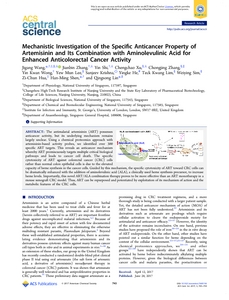Wang, J;
Zhang, J;
Shi, Y;
Xu, C;
Zhang, C;
Wong, YK;
Lee, YM;
Krishna, S;
He, Y;
Lim, TK;
et al.
Wang, J; Zhang, J; Shi, Y; Xu, C; Zhang, C; Wong, YK; Lee, YM; Krishna, S; He, Y; Lim, TK; Sim, W; Hua, Z-C; Shen, H-M; Lin, Q
(2017)
Mechanistic Investigation of the Specific Anticancer Property of Artemisinin and Its Combination with Aminolevulinic Acid for Enhanced Anticolorectal Cancer Activity.
ACS Cent Sci, 3 (7).
pp. 743-750.
ISSN 2374-7943
https://doi.org/10.1021/acscentsci.7b00156
SGUL Authors: Krishna, Sanjeev
![[img]](http://sgultest.da.ulcc.ac.uk/109042/1.hassmallThumbnailVersion/acscentsci.7b00156.pdf)  Preview |
|
PDF
Published Version
Available under License ["licenses_description_publisher" not defined].
Download (2MB)
| Preview
|
Abstract
The antimalarial artemisinin (ART) possesses anticancer activity, but its underlying mechanism remains largely unclear. Using a chemical proteomics approach with artemisinin-based activity probes, we identified over 300 specific ART targets. This reveals an anticancer mechanism whereby ART promiscuously targets multiple critical biological pathways and leads to cancer cell death. The specific cytotoxicity of ART against colorectal cancer (CRC) cells rather than normal colon epithelial cells is due to the elevated capacity of heme synthesis in the cancer cells. Guided by this mechanism, the specific cytotoxicity of ART toward CRC cells can be dramatically enhanced with the addition of aminolevulinic acid (ALA), a clinically used heme synthesis precursor, to increase heme levels. Importantly, this novel ART/ALA combination therapy proves to be more effective than an ART monotherapy in a mouse xenograft CRC model. Thus, ART can be repurposed and potentiated by exploitation of its mechanism of action and the metabolic features of the CRC cells.
Statistics
Item downloaded times since 10 Aug 2017.
Actions (login required)
 |
Edit Item |



